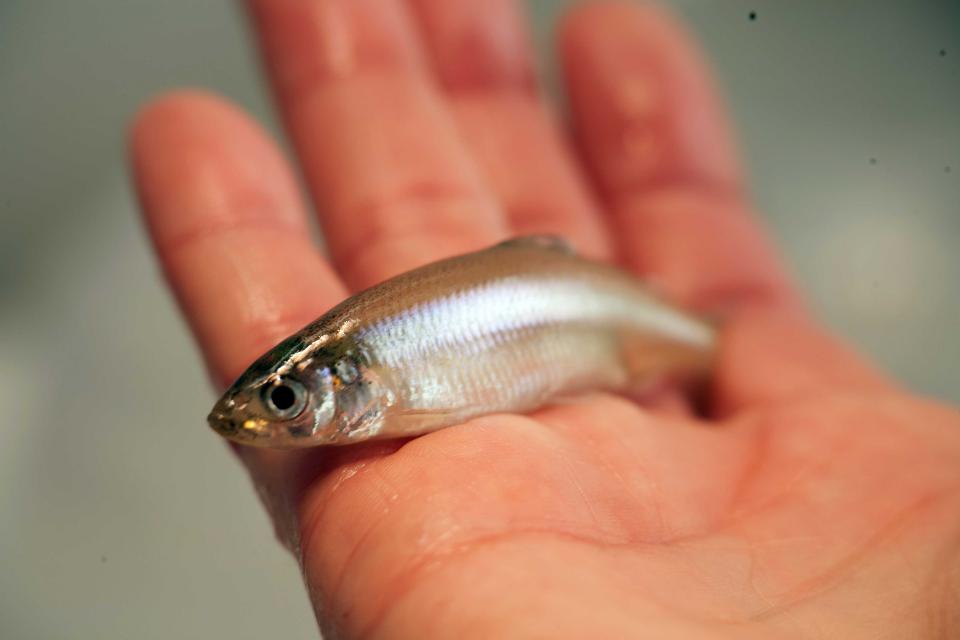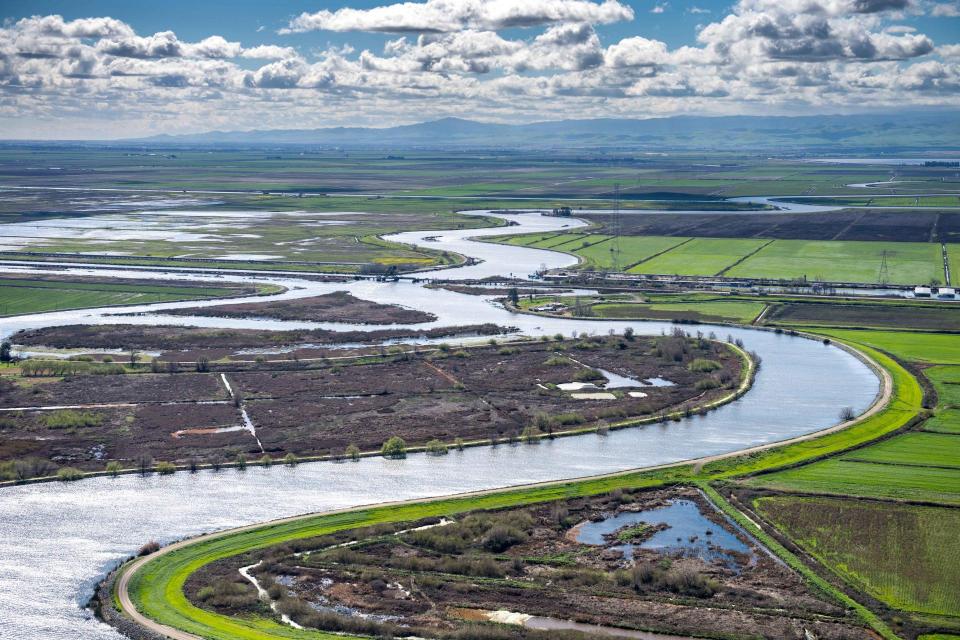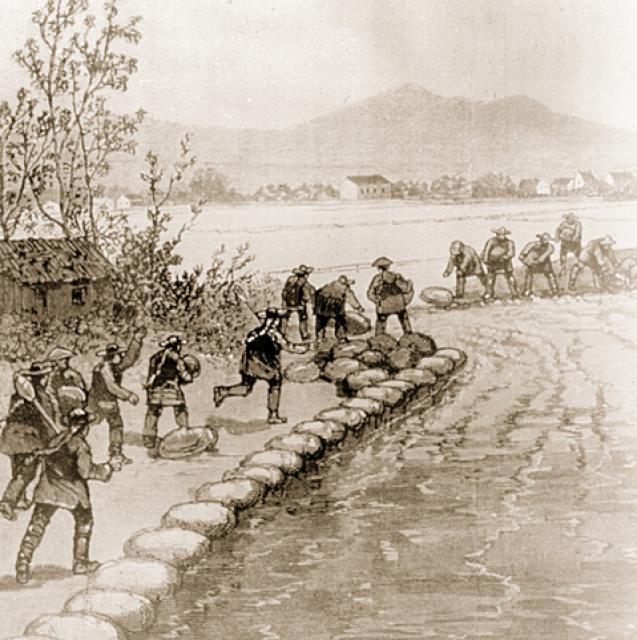Sacramento-San Joaquin Delta Chronology
1772 First recorded sighting of the Bay Delta by Spanish explorers.
1849 Settlers begin farming in the Delta.
1861 Reclamation District Act authorized, allowing drainage of Delta lands and construction of sturdier flood control levees.
1879 The striped bass is brought by rail from the East Coast to the Delta.
1911 Legislature creates Reclamation Board to implement comprehensive flood control plan for Sacramento and San Joaquin rivers.
1935 Congress authorizes federal Central Valley Project. Construction begins in 1937.
1940 Delta water diversions begin with completion of Contra Costa Canal, the CVP’s first unit.
1951 U.S. Bureau of Reclamation constructs the Delta Cross Channel to help move water to the Delta export pumps. The Delta-Mendota Canal begins carrying water south.
1959 Delta Protection Act passed, resolving some issues of legal boundaries, salinity control and water exports.
1960 Voters authorize State Water Project.
1971 State Water Resources Control Board (State Water Board) issues SWP and CVP water quality standards.
1973 New legislation provides funding for certain Delta levees.
Delta Environmental Advisory Committee concludes federal-state Peripheral Canal, properly designed and operated, is necessary to protect the Delta.
1977 Department of Water Resources reaffirms Peripheral Canal as best facility to move water to the Delta export pumps.
1978 State Water Board issues Water Rights Decision 1485 (D-1485) requiring SWP and CVP to meet Delta water quality standards.
1982 Voters defeat Proposition 9, which includes the Peripheral Canal, by 3-2 margin.
1986 Historic DWR-Reclamation accord, the Coordinated Operation Agreement, authorized by Congress.
State Supreme Court affirms “Racanelli Decision” strengthening powers of State Water Board to protect all uses of Delta water.
1987 State Water Board begins to revise D-1485 after U.S. Environmental Protection Agency declares it inadequate.
1988 Suisun Marsh salinity control gates begin operation.
1989 Sacramento River winter-run chinook salmon listed as threatened under Endangered Species Act.
1991 State Water Board adopts updated Bay-Delta Water Quality Control Plan. EPA rejects portions of it under Clean Water Act.
Construction completed on four additional pumps at SWP’s Banks Pumping Plant in the south Delta.
1992 CVP Improvement Act allocates 800,000 acre-feet of water annually to environment. Legislature passes Delta Protection Act, establishing the Delta Protection Commission.
 1993 Delta smelt declared threatened.
1993 Delta smelt declared threatened.
1994 State and federal officials announce Bay-Delta Accord.
Winter-run chinook salmon listed as endangered.
1995 Bay-Delta Plan establishes beneficial uses, associated water quality objectives and an implementation program. In Water Rights Decision 1641, the State Water Board primarily assigns responsibility for meeting Delta water quality objectives to the SWP and CVP.
1998 CALFED releases its latest blueprint for resolving the Delta dilemma — the Revised Phase II Report. The report reaffirms CALFED’s commitment to a staged solution for Delta conveyance.
1999 Sacramento splittail and spring-run chinook salmon listed as threatened under ESA.
2000 CALFED Record of Decision signed.
2002 California Bay-Delta Authority created to oversee implementation and coordination of CALFED program.
2003 Sacramento splittail removed from ESA list.
2004 State Water Board initiates review of 1995 Water Quality Control Plan.
Congress approves long-awaited legislation to reauthorize and help fund the CALFED program.
Scientific surveys reveal ongoing fish population crash.
New law directs DWR to evaluate Delta’s future and rank alternative solutions.
2006 Legal ruling upholds most of D-1641; State Water Board adopts updated water quality plan.
Coalition of fishing groups sues DWR, alleging it never obtained proper legal authority to kill fish while exporting water.
BDCP Steering Committee is formed to create a Habitat Conservation Plan/Natural Community Conservation Plan for the Delta.
2007 SWP Delta export pumping operations temporarily shut down to protect endangered Delta smelt. DWR releases major study (Delta Risk Management Study) that estimates 209 Delta island floodings could occur within the next 100 years.
Gov. Arnold Schwarzenegger endorses a canal to transfer water around the Delta.
2008 Delta Vision Blue Ribbon Task Force adopts the Delta Vision Strategic Plan, a comprehensive set of recommendations that includes legally acknowledging the co-equal status of restoring the Delta ecosystem and creating a more reliable water supply for California.
Gov. Schwarzenegger directs DWR to study at least four Delta water conveyance alternatives.
Public Policy Institute of California states peripheral canal is the best Delta conveyance option for meeting the coequal goals of a healthy Delta ecosystem and water supply reliability.
A court-ordered biological opinion issued by the U.S. Fish and Wildlife Service concludes that Delta smelt were in jeopardy of extinction from the operation of the Delta export pumps.
Pacific Fishery Management Council closes the salmon fishing season throughout California.
2009 Salmon, steelhead and sturgeon in the Central Valley are being driven to extinction by SWP and CVP Delta export facilities and upstream reservoir operations, according to National Marine Fisheries Service draft report.
U.S. District Court Judge Oliver Wanger rules federal government did not analyze impact of Delta smelt protection rules on water exporters.
Congress and the Department of Interior call for National Academy of Sciences to begin a two-year review of the biological opinions issued by both the USFWS and NOAA.
Gov. Schwarzenegger signs a comprehensive water package designed to achieve the coequal goals of ecosystem restoration and water supply reliability.
2010 National Academy of Science releases the first of two reports on Delta operations and finds that “most federal actions to protect endangered fishes in California Bay-Delta scientifically justified, but additional clarification is needed.”
 State Water Resources Control Board
begins hearings on in-Delta diversions.
State Water Resources Control Board
begins hearings on in-Delta diversions.
Judge Wanger rules the federal government did not formulate an adequate plan under the federal ESA when it restricted pumping from the Delta to protect chinook spring-run salmon and other fish. The Ninth Circuit Court overturned the ruling in 2014, saying Wanger’s ruling was based upon scientific evidence he should not have considered and that he should have deferred to the federal agencies’ expertise.
2013 Delta Plan adopted by Delta Stewardship Council.
State releases the draft Bay Delta Conservation Plan (BDCP), which includes 22 conservation measures, new water delivery facilities in the north Delta and measures to restore or protect as much as 150,000 acres of tidal, riparian, wetland and upland habitat.
2015 BDCP is re-envisioned as California WaterFix/EcoRestore. It calls for the construction of two tunnels to draw water from the Sacramento River to state and federal diversion canals near Tracy. It reduces restoration to about 30,000 acres at a cost of about $300 million.
2016 DWR and Reclamation begin consultation for new biological opinions for the CVP and SWP.
Metropolitan Water District of Southern California purchases all or portions of Bacon Island, Bouldin Island, Holland Tract, Webb Tract and Chips Island along the proposed tunnel alignment in the central Delta to help facilitate project.
2018 DWR and participating public water agencies establish the Delta Conveyance Design and Construction Authority. It is charged with final design and construction of WaterFix facilities, under the oversight of DWR.
State Water Resources Control Board adopts plan to restore water flows through the lower San Joaquin, Stanislaus, Tuolumne and Merced rivers.
On parallel tracks, numerous lawsuits are filed by water users, farm and environmental groups challenging State Water Board’s flows plan, while the Brown administration initiates negotiations with water users to develop voluntary agreements intended to achieve equivalent fish and wildlife protections through flow and nonflow measures and increased funding of collaborative science.
CVP and SWP revise the Coordinated Operations Agreement to adjust the allocation of benefits and obligations shared by the two export projects to reflect changing regulatory and other factors.
2019 Gov. Gavin Newsom downsizes the Delta tunnels project to a single tunnel.
U.S. Fish and Wildlife Service and the National Marine Fisheries Service release biological opinions on the Bureau of Reclamation’s proposed operations for the Central Valley Project.
Sacramento-San Joaquin Delta National Heritage Area Act signed into law. The Act establishes the first National Heritage Area in California.
Department of Water Resources releases draft Environmental Impact Report for the long-term operations of the State Water Project.
2020 Newsom administration releases framework for voluntary agreements to manage Delta water flows.
California sues federal government, challenging validity of biological opinions that support Central Valley Project operations.
California Supreme Court affirms the central role of the Delta Stewardship Council in Delta water management and land use planning.
State Water Contractors sue Department of Water Resources regarding endangered species protections included in new State Water Project operating permit.









